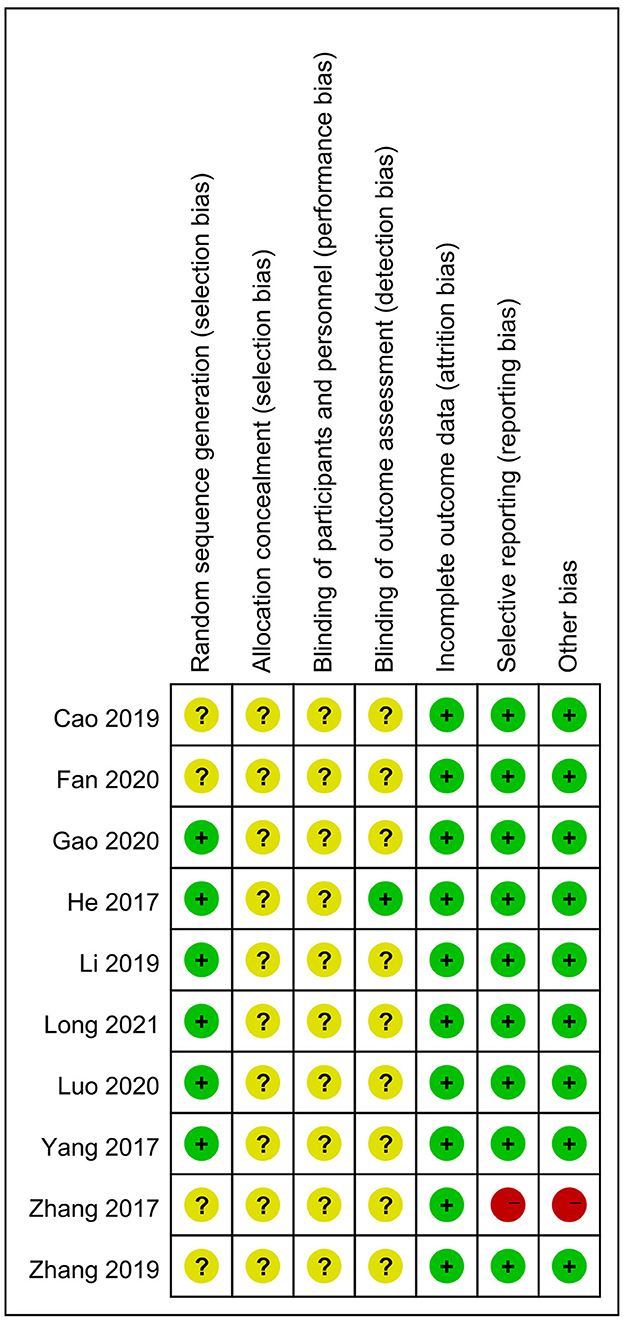- Department of Acupuncture and Moxibustion, Gansu Provincial Hospital of Traditional Chinese Medicine, Lanzhou, Gansu, China
A Commentary on
Acupuncture combined with balloon dilation for post-stroke cricopharyngeal achalasia: a meta-analysis of randomized controlled trials
by Luo, J., Huang, B., Zheng, H., Yang, Z., Xu, M., Xu, Z., Ma, W., Lin, R., Feng, Z., Wu, M., and Cui, S. (2023). Front. Neurosci. 16:1092443. doi: 10.3389/fnins.2022.1092443
We recently read an article in Frontiers in Neuroscience by Luo et al. entitled “Acupuncture combined with balloon dilation for post-stroke cricopharyngeal achalasia: A meta-analysis of randomized controlled trials” (Luo et al., 2023). The authors performed a meta-analysis and concluded that acupuncture combined with balloon dilatation may be an effective treatment for post-stroke cricopharyngeal achalasia. Notably, the authors explored the factors influencing this combination treatment from different perspectives through three subgroup analyses. However, we would like to further improve this important study from two aspects.
The authors highlight the use of the Cochrane Collaboration's risk-of-bias tool by two reviewers to independently assess the methodological quality of each trial. Our main concern was the lack of accuracy in the assessment of the risk-of-bias in the included trials. For example, in several studies (Zhang, 2017, 2019; Cao et al., 2019; Fan et al., 2020), the investigators did not report the method of randomization used, and, therefore, the risk of randomization should have been unknown, rather than low as described by the authors. In the study by Zhang (2017), the Methods section was too brief and did not present specific operational details of the observation and control groups or indicate specific outcome measures. Therefore, there was a high risk of selective publication bias and other biases. Therefore, we reassessed the methodological quality of all articles and presented them in Figure 1.
The included studies used two methods to assess treatment efficacy: the water swallow test (WST) and the videofluoroscopic swallowing study (VFSS). However, the authors only evaluated the difference between the two groups in the VFSS but did not evaluate the WST. Therefore, based on the WST data from three studies (Yang and Lei, 2017; Cao et al., 2019; Long et al., 2021), we found that the intervention group performed better on the WST (Figure 2).
Despite these drawbacks, the benefits of balloon dilatation combined with acupuncture on swallowing function in stroke patients still deserve recognition. The results of this meta-analysis provide solid evidence for the inclusion of this combined intervention in a wide range of stroke patients with dysphagia. In future clinical practice, researchers will need to standardize the best of acupuncture to monitor long-term clinical outcomes. On the other hand, given the homogeneity of the study population (limited to Chinese patients), future studies should continue to expand to other national and regional populations.
Author contributions
HJ wrote the paper. HZ drew the tables. XZ drew the graphs. YX reviewed the article.
Funding
This paper was supported by the Gansu Provincial Natural Science Foundation (23JRRA1247).
Conflict of interest
The authors declare that the research was conducted in the absence of any commercial or financial relationships that could be construed as a potential conflict of interest.
Publisher's note
All claims expressed in this article are solely those of the authors and do not necessarily represent those of their affiliated organizations, or those of the publisher, the editors and the reviewers. Any product that may be evaluated in this article, or claim that may be made by its manufacturer, is not guaranteed or endorsed by the publisher.
References
Cao, X., Xiu-Ling, P. U., Gang, X. U., Cui-Li, Z., Ding, Z., and Wei-Hua, Z. (2019). Clinical study of four-step kaiqiao liyan needling method plus balloon dilation for deglutition disorders due to achalasia of cricopharyngeal muscle after stroke. Shanghai J. Acupunct. 38, 1205–1208. doi: 10.13460/j.issn.1005-0957.2019.11.1205
Fan, P., Bin, L. I., Yan, H., and Ling, Y. (2020). Application of tongue three-needle and temporal three-needle acupuncture combined with balloon dilatation in dysphagia after stroke. Liaoning J. Trad. Chin. Med. 47, 177–179. doi: 10.13192/j.issn.1000-1719.2020.05.053
Long, X., Hao-Ran, C., Pei-Yang, S., Hong-Liang, C., Ling, Z., and Guo-Qing, Z. (2021). Clinical effect of electroacupuncture combined with catheter balloon dilatation in treatment of dysphagia due to achalasia of the cricopharyngeus muscle after stroke. J. Anhui Univ. Trad. Chin. Med. 40, 45–48. doi: 10.3969/j.issn.2095-7246.2021.05.012
Luo, J., Huang, B., Zheng, H., Yang, Z., Xu, M., Xu, Z., et al. (2023). Acupuncture combined with balloon dilation for post-stroke cricopharyngeal achalasia: A meta-analysis of randomized controlled trials. Front. Neurosci. 16, 1092443. doi: 10.3389/fnins.2022.1092443
Yang, F., and Lei, C. (2017). Clinical study on tongue acupuncture plus balloon dilatation for deglutition disorders due to achalasia of the cricopharyngeus muscle after cerebral stroke. Shanghai J. Acup. 36, 261–264. doi: 10.13460/j.issn.1005-0957.2017.03.0261
Zhang, F. (2017). Effect of catheter balloon dilatation combined with acupuncture on patients with cricopharyngeal achalasia after stroke. Dis. Surv. Control 11, 838–839.
Keywords: acupuncture, balloon dilation, stroke, cricopharyngeal achalasia, meta-analysis, commentary
Citation: Jiang H, Zhang H, Zhang X and Xu Y (2023) Commentary: Acupuncture combined with balloon dilation for post-stroke cricopharyngeal achalasia: a meta-analysis of randomized controlled trials. Front. Neurosci. 17:1214834. doi: 10.3389/fnins.2023.1214834
Received: 30 April 2023; Accepted: 24 July 2023;
Published: 24 August 2023.
Edited by:
Ralf Jockers, Université Paris Cité, FranceReviewed by:
Zhaoqin Wang, Shanghai University of Traditional Chinese Medicine, ChinaCopyright © 2023 Jiang, Zhang, Zhang and Xu. This is an open-access article distributed under the terms of the Creative Commons Attribution License (CC BY). The use, distribution or reproduction in other forums is permitted, provided the original author(s) and the copyright owner(s) are credited and that the original publication in this journal is cited, in accordance with accepted academic practice. No use, distribution or reproduction is permitted which does not comply with these terms.
*Correspondence: Yanlong Xu, eGlhb2xvbmc4ODc3MjAyMkAxNjMuY29t
 Hua Jiang
Hua Jiang Yanlong Xu
Yanlong Xu
